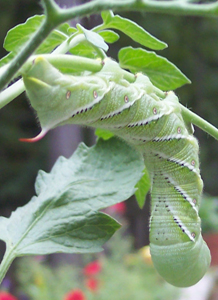Coping with Summer Pests
There is nothing more reminiscent of summer in Southern Arizona than the sound of cicadas buzzing away in the heated stillness. This pleasant humming provides the soundtrack for summers in our region and for those of us who have lived here our entire lives, their return is often a cause for celebration. For vegetable gardeners, the return of the locust is often a bittersweet moment because with it marks the return of a wide variety of insect pests that like to make our summer vegetable gardens home.
Considering that Arizona is home to over 13,000 unique insect species, with many more yet to be discovered, it should come as good news that only a small fraction of these can cause harm to plants in the vegetable garden. Of the three dozen or so that can become a nuisance, only a small percentage require diligence on the part of the gardener to keep them under control. Fortunately, a lot of research has gone into developing control methods for the most destructive backyard garden pests.
Many gardeners shiver at the first appearance of an unknown insect in the garden. Perhaps it’s an innate fear of insects they developed as a child, or perhaps it is effective marketing on the part of poison pushers like pest control companies and pesticide manufacturers. Regardless of the reasoning, the fear is most often a result of a misunderstanding and not grounded in reality. In reality, most insects are harmless and it takes an awful lot of neglect on the part of the gardener to let the damage caused by insects to reach a point that can actually harm garden plants.

Tobacco hornworm, larva of Manduca sexta, on a cherry tomato plant.
photo: Wikimedia Commons
Another reality often overlooked or ignored by gardeners is the fact that the presence of insects, even pest insects, does not necessarily indicate a problem and in fact some of the “damage” caused by these insects can actually be quite beneficial to the plants which are afflicted. Tomato hornworms, for example, perform a great pruning service if not left to take over and can actually encourage new growth of tomato plants. Although they may not do the job exactly as a trained professional would, you can rest assured knowing that your plants will be much better off than the plants down the street that were treated with a toxic pesticide.
The most common response from gardeners when faced with the hornworm or any other leaf chewing caterpillar is to first freak out, and then second to reach for the closest pesticide to deal with the “problem.” Once this cycle is started it is very difficult to get out of. After the adult caterpillars are eliminated, any predatory wasps that may depend on them for breeding will also end up leaving, which in turn can result in the appearance of an even greater number caterpillars in the future. As the cycle progresses, more applications of pesticides are required and the problem is exacerbated.
It may not seem beneficial at first, but there are many positive aspects to the presence of a few pest insects in the garden. As soon as pest insects begin to arrive, it also signals the return of their natural predators. When drastic measures are taken to eliminate the pests, we often unknowingly also eliminate the many predators which naturally keep those pests at bay. These can be insect predators such as the ubiquitous green lacewing or even larger predators such as birds. More often than not, gardeners are too quick to resort tactics that will alter or even eliminate the delicate ecosystem needed to grow a healthy garden.
So what is a gardener to do? No one, including myself, wants to give their garden over to bugs when so much time, work and money have gone into producing a crop. The trick is to approach the situation with a good attitude and to take the least invasive steps possible to eliminate the problem. Although not an instant fix, when basic initial steps are taken we can begin to create a garden environment that is both inhospitable to pest insects and attractive to beneficials.
The first step is to provide your plants with a proper growing environment that meets or exceeds their nutritional requirements. Sickly, malnourished, or drought stricken plants actually attract pest insects while healthy plants actually repel them. Well cared for plants will also bounce back quicker from an attack than those that may be lacking in nutrients. Infestations will rarely occur in a healthy garden. Further steps can be taken to reduce the chance of a pest outbreak. Timing your plantings so that your crops will be well established by the time pests arrive is very effective. A sprawling squash plant will send out roots all along the vine so that if a vine borer severs the main stem the plant will still survive.
Furthermore, by planting cultivars that are already resistant to the most common pests in our region, we can almost eliminate the chance of attack all together. A good example would be butternut and acorn squash, which both are resistant to squash vine borer attack. Further control can be achieved when organic gardening methods are incorporated into your garden plan. The most successful techniques include interplanting of pest repellant plants amongst the garden or even dedicating a small area of the garden to plants that will provide a habitat for beneficial insects.
These methods take time to work and are not instantaneous, but when combined with due diligence on the part of gardener, then the likelihood of your garden being invaded will be greatly reduced. While not as satisfying as emptying a can of Raid, in the long run you and your garden will be much healthier.
Brandon Merchant is the proprietor of Southwest Victory Gardens. Visit his website at SouthwestVictoryGardens.com.
Category: Community, FOOD & DRINK, Nature




